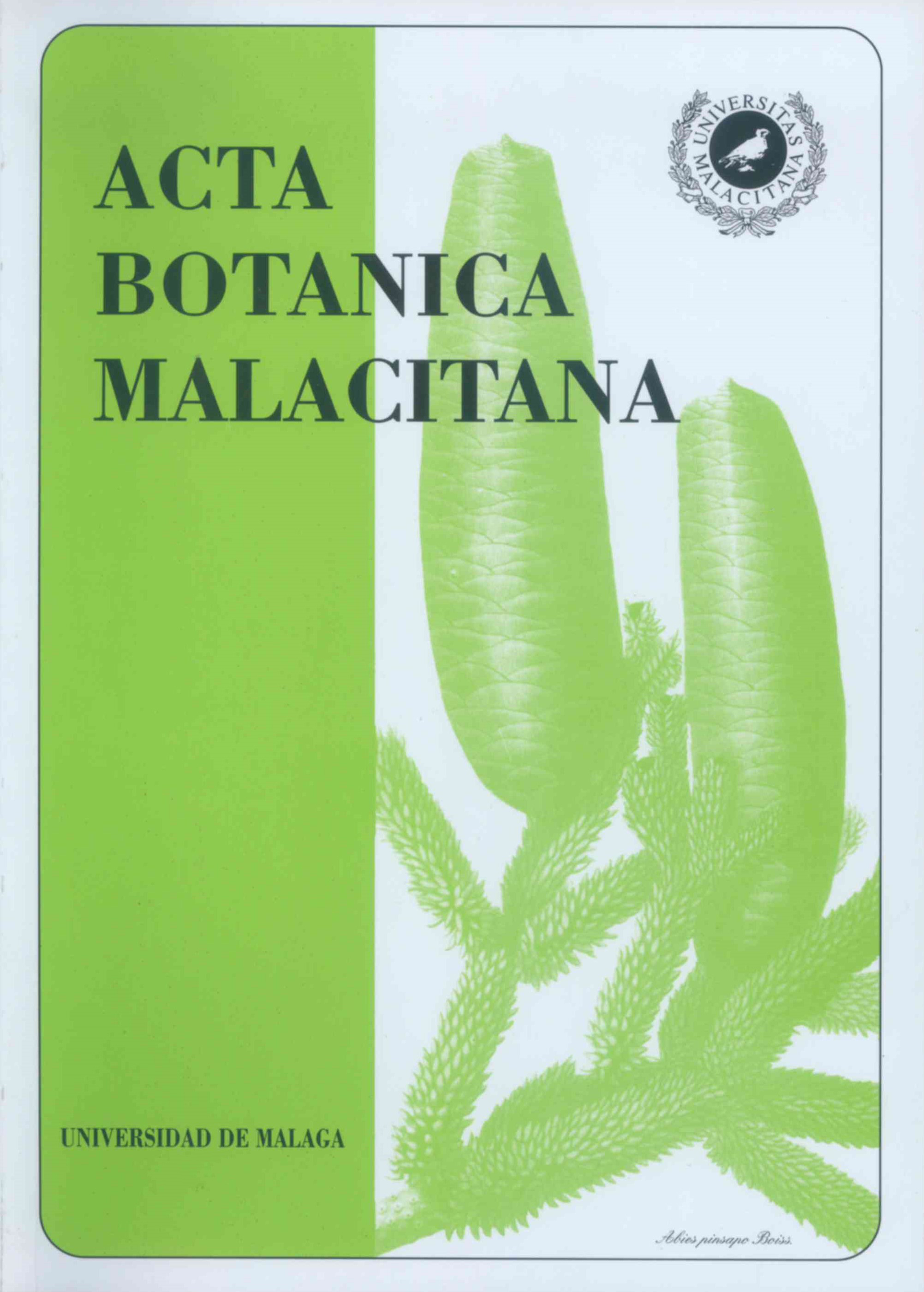Caryological study of the genus Paronychia Miller (Caryophyllaceae) in Andalusia (Spain)
DOI:
https://doi.org/10.24310/abm.v19i.8888Keywords:
Karyology, Paronychia, Caryophyllaceae, Iberian PeninsulaAbstract
A karyological study of six species of the genus Paronychia from the Iberian Peninsula has been made. The basic numbers x=7, 8 and 9 have been found. Caryograms are given in all the species, and for the endemic species P. suffruticosa is reported for the first time.
Downloads
Metrics
References
BORGEN, L. -1969- Chromosome numbers of vascular plants from the Canary Islands with special reference to the occurrence of polyploidy. Norw. J. Bot., 16: 81-121.
BLACKBURN, K. B. & J. K. MORTON -1957- The indicence of polyploidy in the Caryophyllaceae of Britain and of Portugal. New Phytol., 56: 334-352.
CASTROVIEJO, S. -1983- nu?meros cromosoma?ticos de plantas occidentales, 211-222. Anales Jard. Bot. Madrid, 39: 525-531.
CHAUDHRI, M. N. -1968- A revision of the Paronychiinae. Med. Bot. Mus. Herb. Rijks Univ. Utrech, 285: 1-297.
DIANA CORRIAS, S. & R. VILLA -1980- Numeni cromosomici per la flora italiana: 708-713. Inform. Bot. Ital., 12: 131-134.
DIERS, L. -1961- Der Anteil an Polyploiden in den Vegetationsgiirteln der Westkordillere Perus. Zeitschr. Bot., 49: 437-488.
FERNANDES, A. & M. T. LEITAO -1971- Contribuition a? la connaissance cytotaxinomique des Spermatophyta du Portugal. III. Caryophyllaceae. Bol. Soc. Brot., Se?r., 2, 45: 143-176.
FERNA?NDEZ CASAS, J. -1977- Recuentos cromoso?micos en plantas vasculares espan?olas. Saussurea, 8: 33-55.
GALLAND, N. -1985- In A. Löve (ed.) IOPB Chromosome numbers reports, LXXXVII. Taxon, 34: 347-348.
GALLAND, N. -1988- Recherche sur l'origine de la flore orophile du Maroc. Etude caryologique et cytogeographique. Tray. Inst. Sci. Ser. Bot., 35, Rabat.
GALLAND, N. & P. KU?PFER -1984- La diffe?renciation caryologique de quelques orophytes Ouest- Europe?ens-Maghre?bins et le proble?me de leur mise en place. Webbia, 38: 473-490.
KU?PFER, P. -1971- Liens ge?netiques entre les flo- res alpienne et pyre?ne?enne. Acta Coll. Fl. Veg. Alpine et Jurass:, 167-185.
KU?PFER, P. -1974- Recherches sur les liens de parente? entre la flore orophile des Alpes et celle des Pyre?ne?es. Boissiera, 23: 1-322.
LEVAN, A., K. FREDGA & A. A. SANDBERG - 1964- Nomenclature for centromeric position on chromosomes. Hereditas, 52: 201-220.
LOON, J. C., van & H. M. SNELDERS -1979- In A. LOve (ed.) 10PB Chromosome number reports, LXV. Taxon, 28: 632-634.
LORENZO ANDREU, A. y P. GARCI?A SANZ - 1950- Cromosomas soma?ticos de plantas esponta?neas en la estepa de Arago?n. II. Anal. Est. Exp. Aula Dei, 2: 12-20.
LOVE, A. & E. KJELQVIST -1974- Cytotaxonomy of Spanish plants. III. Dicotyledons: Salicaceae- Rosaceae. Lagascalia, 4: 3-32.
LOVE, A. & D. LOVE -1975- Plant chromosomes. Vaduz.
MESQUITA, J. E., de -1953- Contribuição para o conhecimento cariolo?gico das halofitas e psamo?fitas litorais. Diss. Univ. Coimbra, 1953.
SNOW, R. -1963- Alcoholic hydrochloric acid- carmine as a stain for chromosomes in squash preparations. Stain Technol., 38: 9-13.
STEBBINS, G. L. -1938- Cytological characteristics associated with the different growth habits in the dicotyledons. Amer. J. Bol., 25: 189-198.
STEBBINS, G. L. -1971- Chromosomal evolution in higher plants. London.
TJIO, J. J. & A . LEVAN -1950- The use of oxyquinoleine in chromosome analysis. Anal. Est. Exper. Aula Dei, 2: 21-64.
Downloads
Published
How to Cite
Issue
Section
License
All information related to the licensing of published works in Acta Botanica Malacitana and copyright can be found in our Editorial Policy.







1.png)
